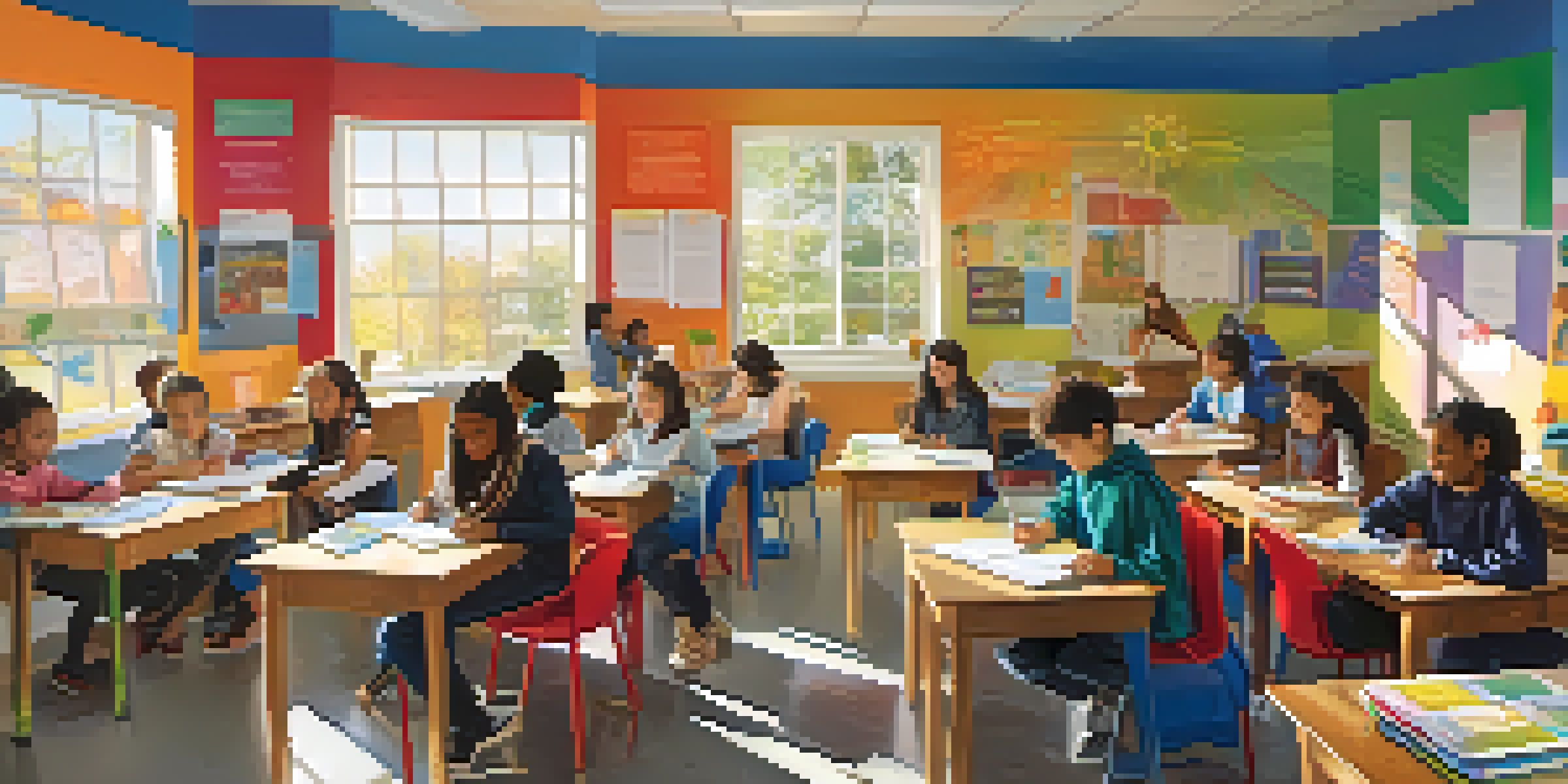Exploring the Impact of Student-Centered Learning on Achievement

Understanding Student-Centered Learning and Its Principles
Student-centered learning shifts the focus from the teacher to the student. It emphasizes active participation, where learners take charge of their education journey. This approach fosters an environment where students can explore their interests and learn at their own pace.
Education is not preparation for life; education is life itself.
At its core, student-centered learning is built on principles like collaboration, critical thinking, and personalization. When students are encouraged to collaborate with peers, they develop essential social skills and deepen their understanding of the material. This tailored approach helps cater to diverse learning styles, making education more inclusive.
By aligning education with students' interests, this method cultivates intrinsic motivation. For instance, when students choose project topics that resonate with them, they are more likely to engage deeply and produce quality work. Ultimately, this empowerment lays the groundwork for a more fulfilling learning experience.
The Role of Teachers in a Student-Centered Environment
In a student-centered learning environment, teachers become facilitators rather than traditional lecturers. This transformation allows educators to guide students in their exploration while providing the necessary support. Instead of delivering information, teachers encourage critical thinking and problem-solving skills.

Teachers also play a vital role in creating a supportive atmosphere. By fostering open communication and building relationships with students, they can better understand individual needs and challenges. This connection enables educators to tailor their support, ensuring that every student feels valued and heard.
Student-Centered Learning Empowers Students
This approach fosters active participation, allowing students to take charge of their education and learn at their own pace.
Furthermore, professional development is crucial for teachers to adapt to this new role. Ongoing training in student-centered practices equips educators with innovative strategies to engage learners. As teachers embrace this shift, they can significantly impact student achievement.
Benefits of Student-Centered Learning on Academic Achievement
The student-centered approach has been linked to improved academic performance. When students engage actively in their learning, they retain information more effectively and apply it in real-world scenarios. This hands-on experience makes the learning process more relevant and exciting.
The greatest gift is not being afraid to question.
Moreover, student-centered learning helps develop essential skills like critical thinking and collaboration. These skills are not only vital for academic success but also prepare students for future careers. Employers increasingly value these competencies, making student-centered learning a win-win.
Research has shown that students in these environments often outperform their peers in traditional settings. They tend to have higher test scores and exhibit a greater depth of understanding. This evidence underlines the positive impact of placing students at the heart of their education.
Challenges in Implementing Student-Centered Learning
While student-centered learning has many advantages, implementing it poses challenges. Resistance from traditional educational structures can make it difficult to shift mindsets. Some educators may feel uncertain about relinquishing control, fearing a loss of authority in the classroom.
Additionally, resource constraints can hinder the successful adoption of this approach. Schools may lack access to necessary tools or training to support these innovative practices. Overcoming these barriers requires a commitment from school leaders and educators to prioritize student-centered methodologies.
Teachers as Facilitators of Learning
In a student-centered environment, teachers guide students' explorations and provide tailored support rather than simply delivering information.
Lastly, balancing curriculum requirements with personalized learning can be tricky. Educators must find a way to meet educational standards while still catering to individual student needs. This balancing act is essential for ensuring that all students achieve their academic goals.
Real-Life Examples of Student-Centered Learning Success
Several schools around the world have embraced student-centered learning with remarkable results. For instance, a high school in California implemented project-based learning, allowing students to explore real-world issues. This approach not only boosted engagement but also led to higher graduation rates.
Another example comes from a middle school in Finland, where students are given a voice in shaping their curriculum. By allowing learners to pursue topics that interest them, the school has seen impressive improvements in student motivation and performance. This flexibility has created a vibrant, engaging learning environment.
These success stories highlight the potential of student-centered learning to transform educational experiences. When students are given agency and responsibility, they thrive academically and personally, demonstrating the effectiveness of this approach.
The Future of Education with Student-Centered Learning
As the educational landscape evolves, student-centered learning is becoming increasingly relevant. With advancements in technology, personalized learning experiences are more accessible than ever. Tools such as online resources and interactive platforms empower students to take charge of their learning journey.
Moreover, the emphasis on social-emotional learning aligns perfectly with student-centered principles. Educators are recognizing the importance of addressing students' emotional well-being alongside academic achievement. This holistic approach fosters resilience and prepares students to navigate life's challenges.
Real-World Success from Student-Centered Learning
Schools implementing this approach have seen impressive improvements in student engagement, motivation, and academic performance.
Ultimately, the future of education lies in embracing student-centered methodologies. By prioritizing student engagement, collaboration, and individualized support, schools can create environments where all learners can thrive and succeed.
Conclusion: Embracing the Student-Centered Approach
In conclusion, student-centered learning offers a transformative approach to education that prioritizes student engagement and achievement. By placing students at the center of their learning experiences, we can cultivate a generation of independent thinkers and lifelong learners. This shift not only enhances academic performance but also prepares students for the complexities of the modern world.
As educators, parents, and communities, it is our responsibility to support and advocate for this approach. By fostering environments that encourage exploration, collaboration, and critical thinking, we can empower students to take ownership of their learning. The benefits of student-centered learning extend far beyond the classroom, shaping the leaders of tomorrow.

Embracing student-centered learning is not just an educational trend; it's a commitment to nurturing the potential of every student. Together, let's work towards a future where education is truly centered around the needs and aspirations of our learners.